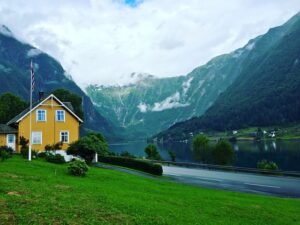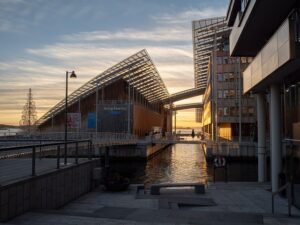

The Beauty of Norwegian: Understanding Descriptive Adjectives
Descriptive adjectives play a crucial role in language, allowing us to add depth and detail to our communication. In the Norwegian language, descriptive adjectives are particularly important, as they help to paint a vivid picture and enhance the overall meaning of a sentence. Whether describing people, nature, or emotions, Norwegian adjectives have the power to bring our words to life. In this article, we will explore the beauty of Norwegian descriptive adjectives and their significance in everyday communication.
Table of Contents
ToggleThe Importance of Descriptive Adjectives in Norwegian Language
In Norwegian, adjectives are used to describe nouns and provide additional information about them. They agree with the gender and number of the noun they modify, which means that they change form depending on whether the noun is masculine, feminine, or neuter, as well as whether it is singular or plural. This agreement between adjectives and nouns is an essential aspect of Norwegian grammar.
For example, if we want to describe a beautiful house in Norwegian, we would say “et vakkert hus” (a beautiful house). Here, the adjective “vakkert” agrees with the neuter gender of the noun “hus.” If we were describing a beautiful car instead, we would say “en vakker bil” (a beautiful car), where the adjective “vakker” agrees with the feminine gender of the noun “bil.”
In everyday communication, descriptive adjectives are used extensively in Norwegian to provide more precise descriptions and convey specific meanings. They allow us to express our thoughts and opinions more effectively and help us to create a clearer picture in the minds of our listeners or readers.
The Role of Descriptive Adjectives in Enhancing Communication
Descriptive adjectives play a crucial role in enhancing communication by adding depth and detail to our descriptions. By using the right adjectives, we can paint a clearer picture and evoke specific emotions or reactions in our audience. For example, instead of simply saying “the sky is blue,” we can use descriptive adjectives to say “the sky is a vibrant shade of azure.” This not only provides a more vivid description but also helps the listener or reader to visualize the scene more effectively.
Using the right adjectives is also important in conveying our intended meaning. For instance, if we want to express that something is small, we can use adjectives like “liten” (small) or “liten” (little). However, if we want to emphasize that something is tiny or minuscule, we can use adjectives like “liten” (tiny) or “miniatyr” (minuscule). By choosing the appropriate adjective, we can ensure that our message is accurately conveyed.
In addition to enhancing communication, descriptive adjectives also allow us to express our thoughts and opinions more effectively. By using adjectives that reflect our emotions or feelings, we can convey our experiences and perspectives in a more nuanced way. For example, instead of saying “I had a good day,” we can say “I had an amazing day” or “I had a fantastic day.” These adjectives provide a stronger emphasis on the positive experience and help to convey our enthusiasm or happiness.
Understanding the Different Types of Descriptive Adjectives in Norwegian
In Norwegian, there are three main types of descriptive adjectives: indefinite, definite, and demonstrative. Indefinite adjectives are used when the noun they modify is indefinite or unspecified. Definite adjectives are used when the noun they modify is definite or specified. Demonstrative adjectives are used to point out or indicate specific nouns.
For example, let’s consider the sentence “Jeg så en vakker blomst i hagen” (I saw a beautiful flower in the garden). Here, the adjective “vakker” is an indefinite adjective because the noun “blomst” (flower) is indefinite. However, if we change the sentence to “Jeg så den vakre blomsten i hagen” (I saw the beautiful flower in the garden), the adjective “vakre” becomes a definite adjective because the noun “blomsten” (the flower) is now definite.
Demonstrative adjectives, on the other hand, are used to indicate specific nouns. For example, if we want to say “this beautiful flower,” we would use the demonstrative adjective “denne” (this) before the adjective “vakre” and the noun “blomsten.”
The Use of Descriptive Adjectives in Describing People and Personalities
Descriptive adjectives are commonly used in Norwegian to describe people and their personalities. By using adjectives that reflect certain traits or characteristics, we can provide a more detailed description of an individual. For example, if we want to describe someone as kind, we can use adjectives like “snill” (kind), “godhjertet” (good-hearted), or “omsorgsfull” (caring).
Similarly, if we want to describe someone as intelligent, we can use adjectives like “intelligent” (intelligent), “klok” (wise), or “smart” (smart). By choosing the right adjectives, we can accurately convey our perception of a person’s personality and create a more vivid image in the minds of our listeners or readers.
Descriptive Adjectives for Describing Nature and Landscapes in Norway

Norway is known for its breathtaking natural beauty, and descriptive adjectives play a crucial role in capturing and conveying this beauty. Whether describing the majestic fjords, the snow-capped mountains, or the lush green forests, Norwegian adjectives help to paint a vivid picture of Norway’s landscapes.
For example, when describing the fjords, we can use adjectives like “majestetisk” (majestic), “imponerende” (impressive), or “vakkert” (beautiful). These adjectives not only convey the grandeur and beauty of the fjords but also evoke a sense of awe and wonder.
Similarly, when describing the mountains, we can use adjectives like “snødekte” (snow-covered), “bratte” (steep), or “majestetiske” (majestic). These adjectives help to create a visual image of the towering peaks and rugged terrain.
How Descriptive Adjectives Help in Expressing Emotions and Feelings
Descriptive adjectives are instrumental in expressing emotions and feelings in Norwegian. By using adjectives that accurately reflect our emotions, we can convey our innermost thoughts and experiences more effectively. For example, if we want to express happiness, we can use adjectives like “lykkelig” (happy), “glad” (glad), or “begeistret” (excited).
Similarly, if we want to express sadness, we can use adjectives like “trist” (sad), “lei seg” (upset), or “deprimert” (depressed). By choosing the right adjectives, we can convey the intensity and nuances of our emotions, allowing others to better understand and empathize with us.
The Art of Using Descriptive Adjectives in Creative Writing in Norwegian
Descriptive adjectives are an essential tool in creative writing, allowing writers to create vivid and engaging narratives. By using adjectives that evoke specific sensory experiences or emotions, writers can transport their readers to different worlds and immerse them in their stories.
For example, instead of saying “the sun was shining,” a writer could use descriptive adjectives like “blazing,” “radiant,” or “golden” to create a more vivid image of the sun’s rays. Similarly, instead of saying “the wind was blowing,” a writer could use adjectives like “howling,” “whispering,” or “gentle” to convey the different qualities of the wind.
By carefully selecting and using descriptive adjectives, writers can enhance the overall impact of their writing and create a more immersive and engaging experience for their readers.
Common Mistakes to Avoid When Using Descriptive Adjectives in Norwegian
While descriptive adjectives are a powerful tool in Norwegian language, there are some common mistakes that learners should avoid. One common mistake is using the wrong form of the adjective to agree with the gender and number of the noun. For example, using “vakre” instead of “vakker” when describing a singular feminine noun.
Another common mistake is using adjectives that are too general or vague. Instead of using generic adjectives like “fin” (nice) or “bra” (good), it is better to use more specific and descriptive adjectives that accurately convey the intended meaning.
Additionally, it is important to avoid overusing adjectives or using them unnecessarily. While descriptive adjectives can enhance communication, using too many adjectives can make the sentence cluttered and confusing. It is important to strike a balance and use adjectives sparingly when they add value to the sentence.
To avoid these mistakes, learners should practice using descriptive adjectives in context and seek feedback from native speakers or language instructors.
Appreciating the Beauty of Norwegian Descriptive Adjectives in Everyday Communication
In conclusion, descriptive adjectives play a vital role in Norwegian language, allowing us to add depth and detail to our communication. Whether describing people, nature, emotions, or landscapes, Norwegian adjectives have the power to bring our words to life and enhance our overall message. By understanding the different types of adjectives and using them correctly, we can effectively convey our thoughts, emotions, and experiences in a more nuanced and engaging way. So let us appreciate the beauty of Norwegian descriptive adjectives and embrace their power in everyday communication.
If you’re interested in learning more about descriptive adjectives in Norwegian, you might also enjoy reading the article “Mastering Compound Noun-Noun Structures in Norwegian.” This article delves into the intricacies of forming compound nouns in Norwegian and provides helpful examples to enhance your understanding. Check it out here.
If you want to learn Norwegian, you can register for classes here. We look forward to hearing from you and helping you become fluent in Norwegian.





